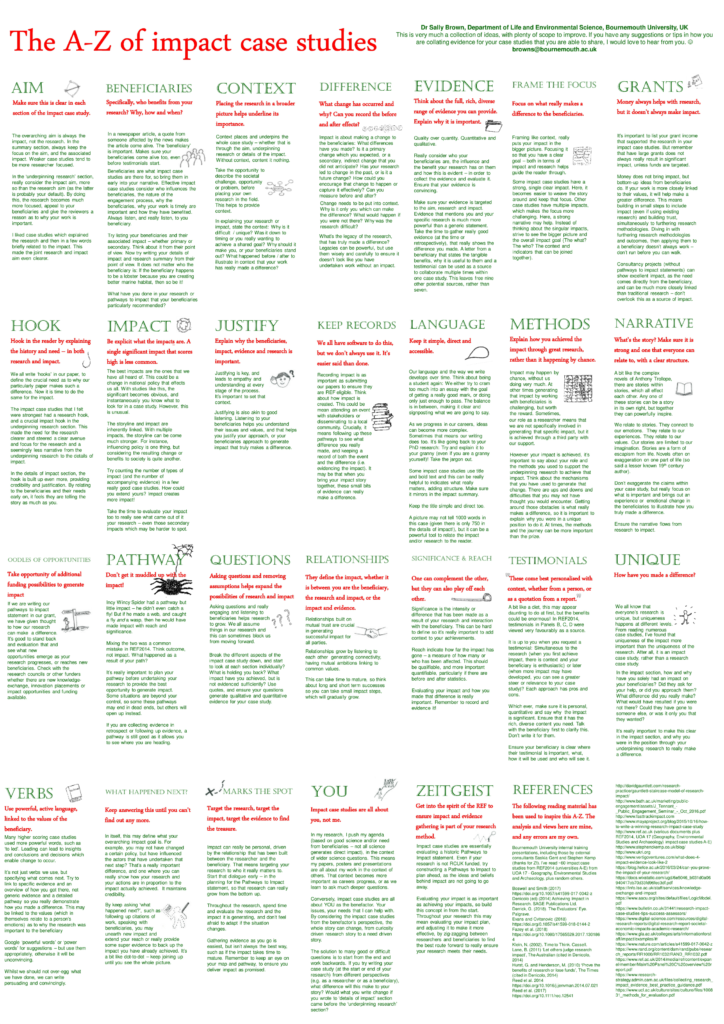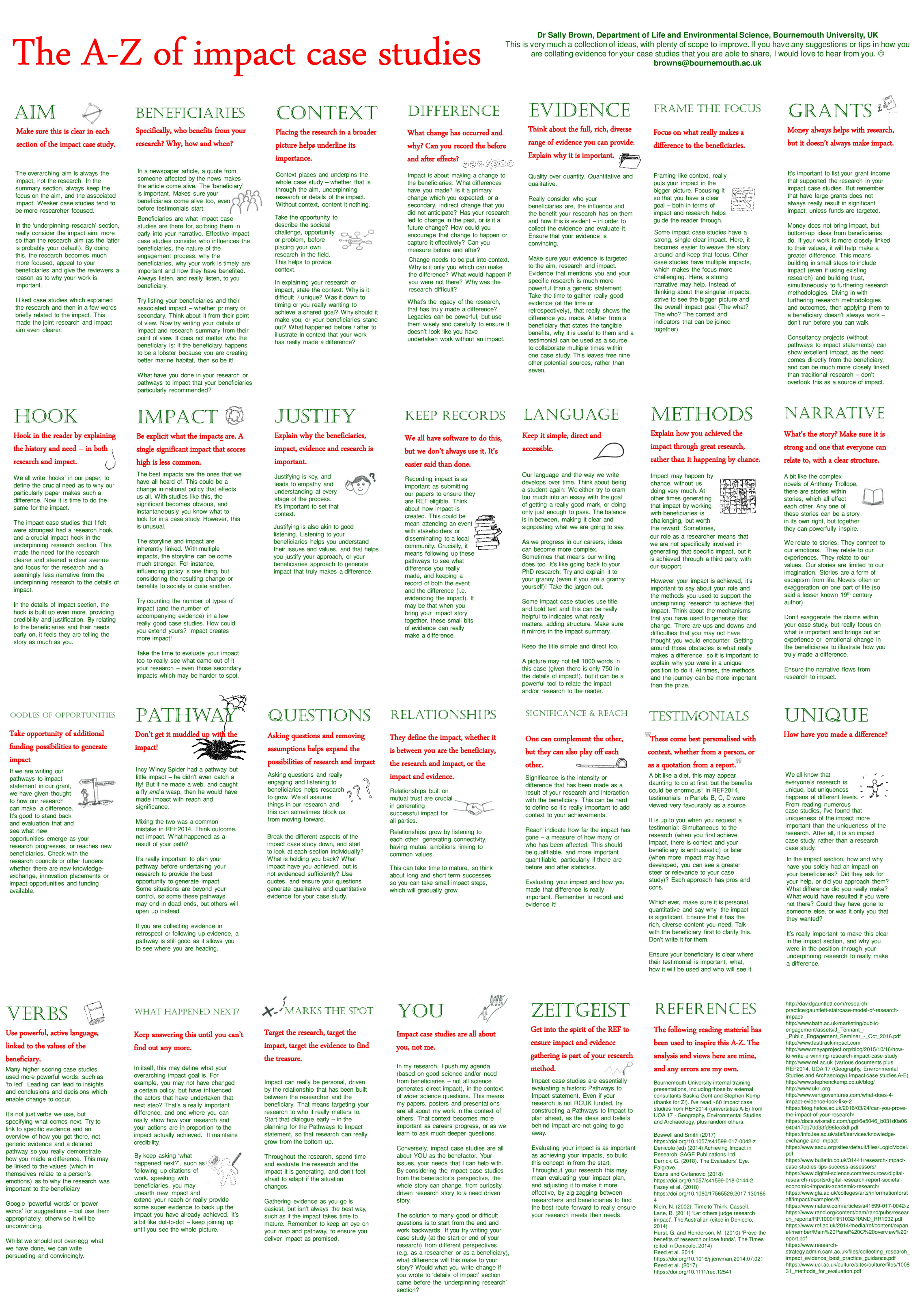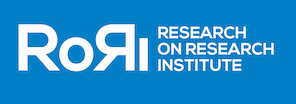The A to Z: Tips for Writing an Impact Case Study
“Errr….exactly how do I write my impact case study?”
I was asked this question earlier in the summer, shortly after starting my new role at Bournemouth University, helping to generate evidence of impact ahead of REF 2021. Never having written a case study myself, I didn’t know the answer, and so needed to find out. I discovered there is a wealth of information on what a case study is and how to generate impact, but not on how to write one, so I took that as my starting point. From past experience of undertaking research, I have found the key part is breaking the question down into different “blocks” and analyzing them from different perspectives. Impact case studies are the opposite: you already have the blocks – evidence in different parts and perspectives – and it’s up to the researcher to use them to create a coherent story. What I needed was a clear, short, effective, and memorable method to communicate this to impact case study leaders; and so I created an A to Z.
Having undertaken extensive reading and reviewed a number of case studies from REF 2014, I decided the A-Z was best divided into three parts: (1) an impact aim; (2) research and impact evidence; and (3) a narrative to build the story around the blocks of evidence. Rather than in alphabetical order, my A to Z is presented here in these three parts. (The full A to Z graphic appears at the bottom of this post.)
Aim
Tempted as we are to write in our comfort zone (i.e. about our research), it’s important to emphasise the impact aim over the research aim – after all this is an impact case study, not a research case study. Doing this frames the focus of the case study, which you can then link to the purpose of the research – after all impact is all about you, not me. It also makes it exciting to follow how that impact was achieved.

The aim should ideally also define the difference that has been achieved. In many ways this is defined by the researcher and beneficiary from the start. Be clear about the beneficiaries – did they approach you, you approach them, or a chance meeting? How did that relationship start? What would they say about you if they wrote it from their perspective? Impact case studies from consultancy work are easier to define here as the beneficiary (or client) had a clear need.
Methods are also important in how you undertook your research and achieved your impact. Did it happen by chance? Did you really have to drive the impact yourself? Were you a small part of a bigger picture? An outline here is really useful as the reader can understand how difficult it was, what the challenges were, and how the researcher made a difference. If an impact was hard to achieve, does that warrant a higher score? Remember, the pathway to impact is important, but the case study should focus on the outcome of that pathway, not the pathway itself.
Research and impact evidence
Evidence is key throughout as the assessors are not an expert in any one subject. Therefore, it’s also important to justify your impact claim and evidence, and also explain its context. For instance, if it’s the first time something has been achieved and is solely dependent on your work, then say so – explain why it is unique.
Evidence may be sought at the time of impact (which is good whilst it is fresh in the mind(s) of either you or your beneficiaries), or in retrospect (when more impact may have occurred, the impact may have matured, or when you have a clearer view of the whole case study, taking account of all the evidence). Just remember to keep records (e.g. dates, meetings, names, outcomes). Also remember that X marks the spot – really target your evidence throughout: testimonials can be compelling and personal if used appropriately, so take time and thought to gather these, with the best quotations used judiciously within the final case study.
There are oodles of opportunities to pursue, which may follow up on existing impact, generate new impact, or work with stakeholders on knowledge exchange through grants or other networking opportunities.
Throughout my reading, I also started to question “what would have happened if the research didn’t happen? What alternatives are there? Would this have really affected the impact?” This is where the concepts of significance and reach come in; these can really help to put an impact case study into perspective.
Narrative
Once you have your impact aim and evidence, you need to weave your story together. For REF 2014, some universities used professional writers to help. After all, impact case studies need a different writing style to proposal or paper; one which is clear and understandable to someone unfamiliar with your subject. The beauty of excellent impact case studies lies in their simplicity.
When it comes to the narrative, I’ve tried to consider this from different perspectives – what if the beneficiaries wrote my case study? I’m sure each one would say something different! These different styles really come through in the section describing the impact summary. Some case studies I reviewed could, I feel, have given more and failed to fully answer the “what happened next?” question. The evidence didn’t quite link up with the aim, or left the impression that a little more might’ve been squeezed out, as the distance between the researcher and beneficiary seemed too great.
Similar to writing journal articles, impact case studies, both in their underpinning research and details of impact sections, must have a hook. This is important to identify and creates a hinge to the aim. In REF 2014, higher-ranked case studies used simple and persuasive language and powerful “doing” verbs.
Nearly there with your case study? Go back and ask yourself questions that really break down your research and/or impact assumptions, so that you can fully understand your beneficiaries’ needs and the scope of the impact. What have you achieved that hasn’t been evidenced sufficiently? Ask a colleague to read through your case study to help to find the gaps.
Summary
We are in the zeitgeist of impact, where the need to justify our research and evidence societal benefits has never been greater. Generating impact is a skill, as is writing an impact case study. Whatever your impact, keep a clear focus, and with a firm research foundation, build those blocks of evidence into a strong tower that is worth writing about!






























































































In order to write an impact case study, you must first determine who will benefit specifically. You must be able to show how the effort affected the recipients.
The first step in writing an impact case study is to identify the specific beneficiaries. You must be able to demonstrate the impact the initiative had on the beneficiaries. Be clear about the relationship between the project and the beneficiary. If the beneficiary was clear about their needs, this is easier to achieve. If not, include a brief description of the program and its impacts. In addition, you should include testimonials from people who were directly affected by the initiative.
Good one
Great list!! I’ve heard of several of those, but have only tried a few.
It might be helpful to quickly clarify what was unique or particular about the exploration that added to the effects